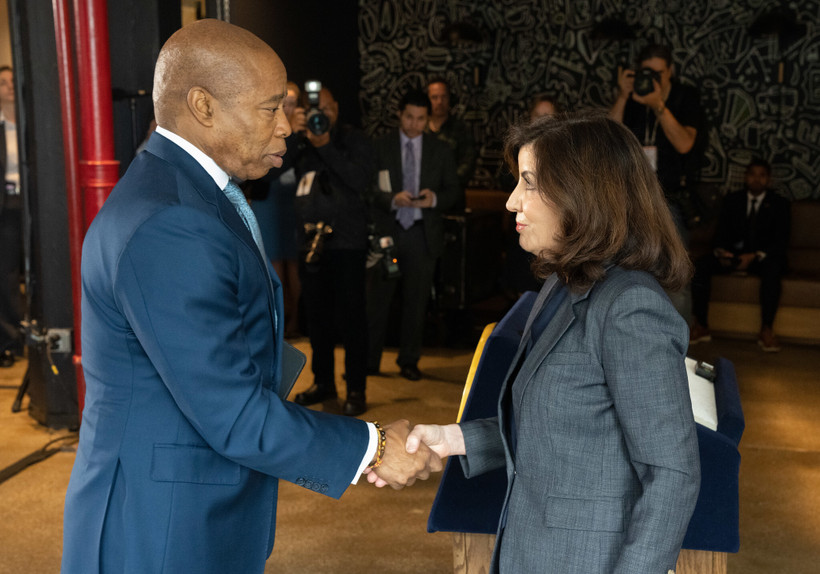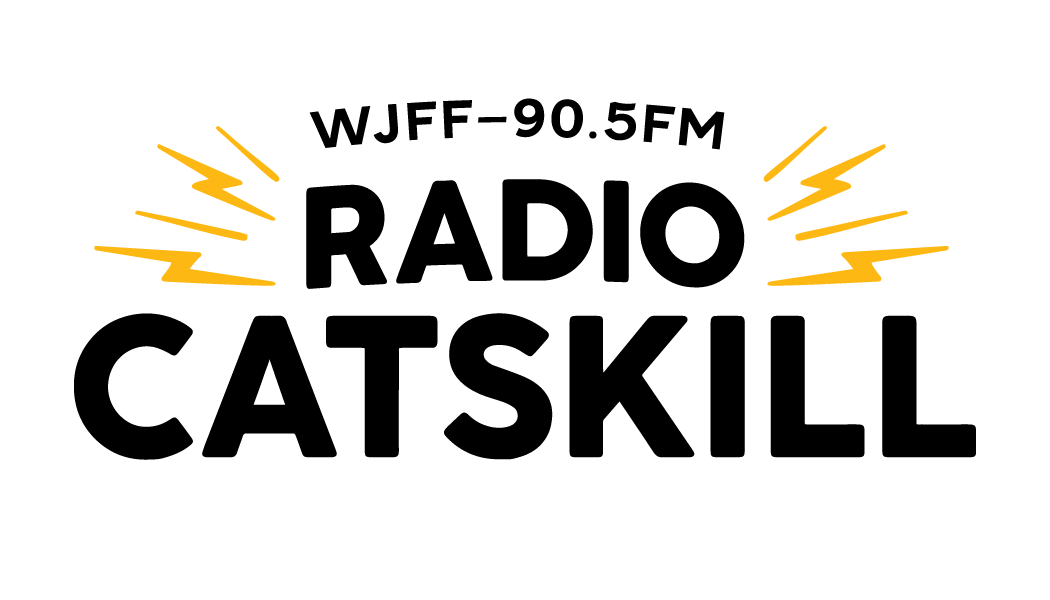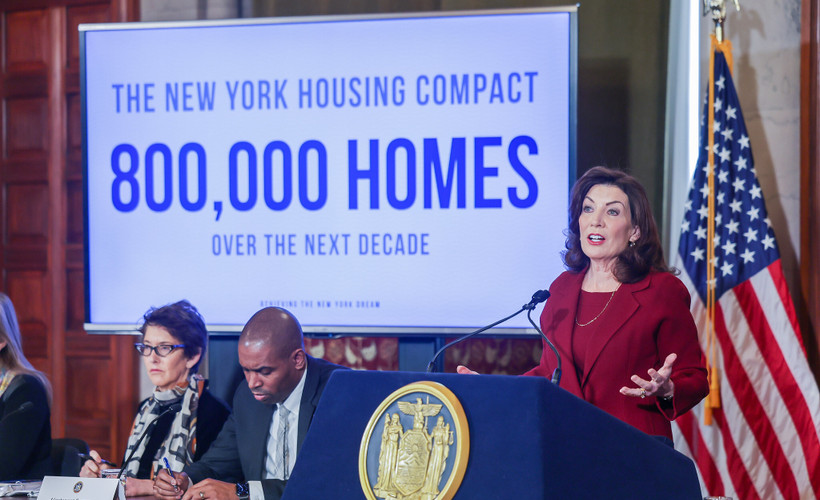 As a humanitarian crisis deepens, the state’s $25 million solution is off to a slow start. An in-depth look at the opaque program reveals a raft of logistical hurdles and strict eligibility requirements.
As a humanitarian crisis deepens, the state’s $25 million solution is off to a slow start. An in-depth look at the opaque program reveals a raft of logistical hurdles and strict eligibility requirements.
By: Andrew Giambrone · August 29, 2023
This story originally appeared in New York Focus, a non-profit news publication investigating how power works in New York state. Sign up for their newsletter here.
THROUGHOUT THE SPRING, thousands of migrants piled into New York City homeless shelters, often with small children and having traveled thousands of treacherous miles to cross the United States’ southern border.
As the mayor griped, Republican governors sent more migrants on city-bound buses, and shelters routinely reached capacity. In response, the state launched an ambitious program to resettle asylum-seeking families to other parts of New York, hoping to relieve pressure on the city and provide migrants more suitable housing.
So far, the $25 million program has relocated zero families.
The Migrant Relocation Assistance Program (mrap) was created to move up to 1,250 families out of New York City shelters with rental assistance and a panoply of social services, including case management. While the program would support less than a tenth of the more than 13,600 migrant families in the city’s care as of July 30, proponents say mrap offers a promising new pathway for asylum seekers to establish themselves in communities statewide while freeing up scarce shelter space.
Crucially, participation is voluntary: Families must opt in by signing a consent form and engage in multiple conversations about relocation options. To qualify, at least one adult per household must have applied for asylum or other immigration relief that opens the door to a work permit — an onerous process limiting program enrollment.
“We’ve been talking about something like this for a long time,” said Matt Tice, director of Vive Shelter in Buffalo, which is overseen by one of four nonprofits the state selected to implement the program. “So it’s really exciting to see a system that mirrors refugee resettlement much more than some of the other ways that have been thrown together recently for helping asylum seekers.”
Details about the program have been relatively opaque — until now. New York Focus is the first to report in depth on mrap, based on a review of public records, state contracts obtained through a Freedom of Information Law request, and accounts from service providers, migrant advocates, and government agencies.
New York Focus found that a raft of logistical hurdles and strict eligibility requirements threaten to hobble mrap as it tries to get off the ground. The program demands a high level of coordination from government and nonprofit workers already stretched thin by the migrant influx and an interrelated housing and homelessness crisis, with neither situation set to abate anytime soon.
As the humanitarian disaster intensifies, both New York Governor Kathy Hochul and New York City Mayor Eric Adams have stressed the importance of quickly moving asylum seekers from emergency shelter to housing. But the two leaders have clashed over resettlement procedures, suggesting that political tensions between the state and city could be impeding mrap.
In a sign of the challenges, the state and city furnished New York Focus with conflicting figures on the number of families referred for the program so far. The state Office of Temporary and Disability Assistance (otda), which has lacked a permanent commissioner since July, said that as of August 28, 129 families had been deemed eligible and interested and had begun receiving case management services to facilitate a move. The New York City Department of Social Services (dss), however, said that as of August 22, it had referred 368 eligible and interested families to the state. When asked for clarification, each agency stood by its data.
The city is responsible for initially screening and referring families for mrap, even though it is a state program. Officials from both levels of government acknowledged that the arrangement has yielded inconsistent information sharing about families — some of whom have declined to move forward after being identified as eligible.
In a statement, otda said the 129 families it cited “are in the early stages of the Program and will be resettled as soon as possible, and we look forward to further partnership with the City to ensure as many families as possible are enrolled.” dss said it is “setting up critical relocation management and coordination services for eligible households” in collaboration with New York City Health and Hospitals and “with long-overdue support from the State.”
How many families ultimately resettle through the program — and how quickly and smoothly — remains to be seen. Earlier this month, even as Hochul announced an additional $20 million to advance asylum casework, along with a color-coded triage system based on migrants’ “barriers to exiting shelter,” she indicated that the state would expand mrap only if it proves successful.

STATE LAWMAKERS APPROVED mrap in a month-late budget in early May, as part of a more than $1 billion outlay for aiding asylum seekers that Hochul had proposed in her latest spending plan.
On May 9, the governor declared an emergency over the migrant crisis and temporarily suspended standard government procurement rules so that the state could respond more nimbly to any exigencies. She has since extended this “state disaster emergency” several times.
Under the emergency, otda in late June hired four nonprofits to carry out mrap and help asylum seekers move from New York City to one of five designated counties: Albany, Erie, Monroe, Suffolk, and Westchester. The organizations include the Ibero-American Action League, Jericho Road, sepa Mujer, and Neighbors Link. All have extensive experience working with immigrants and decades-long track records in New York.
mrap offers asylum-seeking families up to a year of rent payments and various wraparound services, ranging from employment counseling and medical care to transportation and school enrollment. To be eligible, participants must reside in a New York City shelter and demonstrate that an adult in their household has or is tracking toward federal work authorization, such as by having applied for asylum or other legal status.
The latter requirement has restricted the number of families immediately eligible for the program, as many in the city’s care were released into the United States pending immigration court hearings and have not applied for asylum yet. Filing for asylum status, which confers protection from deportation and other privileges, is a complex legal process that generally must be completed within a year of arriving in the United States.
“Ideally, you’d want to prioritize people who were running up against the one-year deadline to file,” said Kathryn Kliff, a staff attorney at the New York City-based Legal Aid Society, which is defending the rights of unhoused people in an ongoing court case over local shelter laws. “We don’t know if they’re prioritizing people based on date of entry [into the country], which would let them maximize how many people they’re helping and make sure they meet the deadline.”
Neither otda nor dss responded to questions about whether mrap is prioritizing migrants in the manner Kliff described.
“It’s been very slow moving,” she said.
A recent study by the American Immigration Lawyers Association estimated a minimum of 50 to 75 hours for an attorney experienced in asylum law to prepare a basic asylum petition. But, the report found, “most asylum cases are not straightforward,” as they are complicated by applicants’ past trauma, language barriers, and the need to collect evidence from abroad — so applications can take significantly longer.
“It’s been very slow moving.”
“Many people could say that a year is enough time to apply, to find a lawyer, but in some cases it’s not that easy,” said Héctor Arguinzones, who left Venezuela with his son in 2014 and was joined by his wife the following year. The couple founded the grassroots group Venezuelans and Immigrants Aid to support asylum seekers, and Arguinzones said he has recently heard of many people missing or nearing the application deadline. “We always encourage [people] to follow the process,” he noted.
The Adams administration has asked the state to drop the application requirement and otherwise expand mrap, but Hochul’s team has so far largely rebuffed these requests. “It is not advisable to extend this resettlement program to households that have not yet applied for asylum,” Faith Gay, an attorney representing Hochul in the shelter litigation, wrote in a footnote in an August 15 letter to city Corporation Counsel Sylvia Hinds-Radix. (State officials told New York Focus that the program’s eligibility rules have been clear from the start.)
The letter, first disclosed by The New York Times, also states that relocation “can further delay migrants’ ability to work and obtain self-sufficiency,” since asylum seekers commonly request to change venue in immigration court when they move far away, and this effectively pauses the mandatory 180-day period between when someone petitions for asylum and when they can obtain work authorization. Major immigration court backlogs have only complicated matters.
“Many people could say that a year is enough time to apply, to find a lawyer, but in some cases it’s not that easy.”
Currently, “the wait period before an asylum seeker can receive a work permit is too long,” said Conchita Cruz, co-founder and co-executive director of the membership-based Asylum Seeker Advocacy Project. “We’ve been working with members of Congress on bipartisan legislation to bring that number down to 30 days after someone applies for asylum.”
For months, Hochul, Adams, and other prominent New York Democrats have urged the federal government to expedite work permits for asylum seekers. While that result appears far from guaranteed, it would likely improve outcomes for those considering resettlement and reduce shelter stays in New York City, where a right to shelter dating to 1981 mandates emergency beds for anyone who needs one.
“People want to go where there’s work,” said Kliff. “If there’s work and the ability to work, people will go.”
THE BULK OF the $25 million allocated to mrap is budgeted for rental assistance, state contracts reviewed by New York Focus reveal. The four nonprofits brought on to implement the program are responsible for securing “safe, sanitary, and affordable living quarters” and providing access to immigration legal services for participants through May 2025.
Work plans included in the contracts say these groups will scour local listings and connect with landlords, partner organizations, tenant councils, and realtors to find homes for asylum seekers. In their first 30 days in their new communities, families will get intensive case management and financial assistance for essentials like furniture, food, and clothing. For the rest of a family’s time in mrap, the nonprofits must conduct a “housing needs assessment every 90 days to adjust the housing subsidy as appropriate” — for example, after a household member gains employment.
“Our main objective will be to make the families feel welcome,” the Ibero-American Action League, one of the nonprofits, wrote in its plan. “We will support their integration by providing community orientation, and advice, and addressing their basic needs.” The organization, which is active in Rochester and the Capital Region, will assign families “self-sufficiency scores” based on an initial intake assessment measuring an array of factors, to help asylum seekers come up with and achieve their own goals for getting settled.
“For us, self-sufficient is when families feel they’re doing well and they’re stable, and that can look different for different families,” said Angelica Perez-Delgado, Ibero’s president and ceo. “Finding housing they can remain in and build their lives in is the biggest challenge we have, but once we find them housing, we can give them resources.”
“You are responsible for understanding any effects that relocating could have on your immigration case or other legal matters.”
In addition to the contracts, New York Focus obtained a two-page document created by otda that describes asylum seekers’ “rights and responsibilities” under mrap. The document warns that “failure to comply with any of the below responsibilities may result in the discontinuation of your participation in the program.” Among them: filing a change of address form with us immigration officials, working with a legal services provider on stabilizing one’s immigration status, and providing proof of identity, income, and other information to receive services.
“You are responsible for understanding any effects that relocating could have on your immigration case or other legal matters,” the document reads. “If you are authorized and able to work, you must accept any job offered to you that you are able to do [and] you are responsible to contribute to your family’s housing and household expenses.” (otda confirmed the authenticity of the document and said it has been distributed in languages other than English.)
As mrap struggles to get off the ground, dozens of mostly Republican-led counties have sought to block the city from sending them migrants — now the subject of an acrimonious legal battle. Meanwhile, reports have emerged that government contractors used misleading and harassing methods to transport asylum seekers from the city to upstate hotels. This has made it even more challenging to persuade migrants who have undergone long and often traumatic journeys to accept resettlement assistance, immigrant advocates say.
“We have to show people we’re worth their trust,” said Tice, the director at Jericho Road’s Vive Shelter. “That you will be safe. That this is a great opportunity for your next steps.”
“My hope is that once people make the move and start to tell others, and they see this is a good thing, then it will pick up momentum,” he added.




